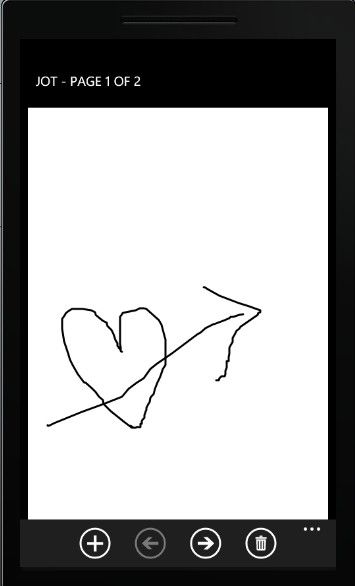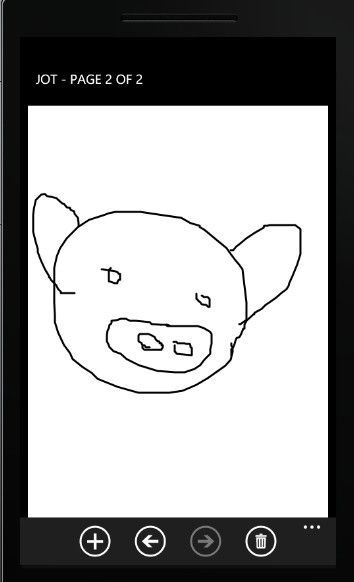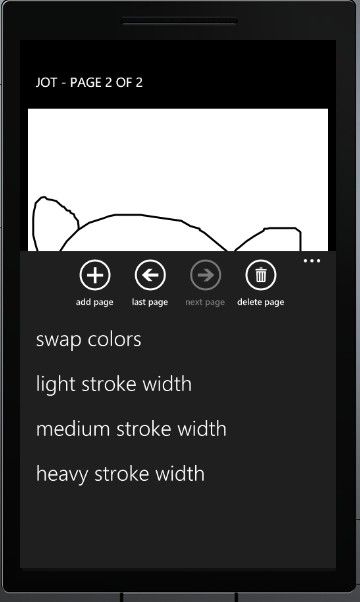Windows Phone 7 多点触摸编程
一、基本的程序结构
一个需要响应多点触控的 Silverlight 应用程序必须将一个处理程序连接到静态 Touch.FrameReported 事件:
Touch.FrameReported += OnTouchFrameReported;
FrameReported 事件是静态 Touch 类的唯一公共成员。处理程序如下所示:
void OnTouchFrameReported(
object sender, TouchFrameEventArgs args) {
...
}
您可以在应用程序中安装多个 Touch.FrameReported 事件处理程序,所有这些事件处理程序都会报告应用程序中任何位置的所有触控事件。
二、事件传入参数TouchFrameEventArgs
TouchFrameEventArgs 有一个名为 TimeStamp 的公共属性(我还没有机会使用)和三个重要的公共方法:
TouchPoint GetPrimaryTouchPoint(UIElement relativeTo)
TouchPointCollection GetTouchPoints(UIElement relativeTo)
void SuspendMousePromotionUntilTouchUp()
GetPrimaryTouchPoint 或 GetTouchPoints 的参数仅用于报告 TouchPoint 对象的位置信息。您可以将空值用于此参数,位置信息相对于整个 Silverlight 应用程序的左上角。
多点触控支持多个手指同时触摸屏幕,触摸屏幕的每个手指(数量存在上限,当前通常为两个)都是一个触摸点。主要触摸点是指在没有其他手指触摸屏幕并且未按下鼠标按钮时触摸屏幕的手指。用一个手指触摸屏幕。这是主要触摸点。
在第一个手指仍触摸着屏幕时,将第二个手指放在屏幕上。很显然,第二手指不是主要触摸点。但现在仍将第二个手指放在屏幕上,抬起第一个手指,然后再将其放回到屏幕上。这是主要触摸点吗?不,都不是。仅当没有其他手指触摸屏幕时,才会出现主要触摸点。
在实际的多点触控应用程序中,您应该注意不要依赖主要触摸点,因为用户通常不会重视第一次触摸的特定意义。仅为实际触摸屏幕的手指激发事件。对非常接近屏幕但并未触摸屏幕的手指,不会进行悬停检测。
基于一个触摸点或多个触摸点激发一个特殊的 Touch.FrameReported 事件。从 GetTouchPoints 方法返回的 TouchPointCollection 包含与特定事件关联的所有触摸点。从 GetPrimaryTouchPoint 返回的 TouchPoint 始终是一个主要触摸点。如果没有与该特定事件关联的主要触摸点,GetPrimaryTouchPoint 将返回 null。即使从 GetPrimaryTouchPoint 返回的 TouchPoint 不是 null,它也不会与从 GetTouchPoints 返回的其中一个 TouchPoint 对象是相同对象,但在传递给这些方法的参数相同时所有属性将相同。
TouchPoint 类定义以下四个只读属性,这些属性都由依赖属性支持:
Action 属性,类型为 TouchAction(一个具有 Down、Move 和 Up 成员的枚举)。
Position 属性,类型为 Point,它相对于作为参数传递给 GetPrimaryTouchPoint 或 GetTouchPoints 方法的元素(或相对于参数为 null 的应用程序的左上角)。
Size 属性,类型为 Size。
TouchDevice 属性,类型为 TouchDevice。
TouchDevice 对象具有两个也由依赖属性支持的只读属性:
DirectlyOver 属性,类型为 DirectlyOver(手指下最上面的元素)。
Id 属性,类型为 int。
DirectlyOver 不必是传递给 GetPrimaryTouchPoint 或 GetTouchPoints 的元素的子项。如果手指在 Silverlight 应用程序内(由 Silverlight 插件对象的尺寸定义),但不在可点击测试控件覆盖的范围内,则此属性可以为空。(具有空背景刷的面板不可点击测试。)
若要在多个手指之间区分,ID 属性至关重要。在特定手指触摸屏幕时,与该手指关联的一系列特定事件总是以 Down 操作开始,接着是 Move 事件,最后是 Up 事件。所有这些事件都将与相同的 ID 关联。(但不要以为主要触摸点的 ID 值将为 0 或 1。)
大多数重要的多点触控代码都会使用 Dictionary 集合,其中 TouchDevice 的 ID 属性是字典键。这是跨事件存储特定手指信息的方式。
三、涂鸦板例子
涂鸦板例子 综合运用ApplicationBar菜单、多点触摸和IsolatedStorageFile本地存储



xaml
 View Code
View Code
<
phone:PhoneApplicationPage
x:Class
="Jot.MainPage"
xmlns
="http://schemas.microsoft.com/winfx/2006/xaml/presentation"
xmlns:x
="http://schemas.microsoft.com/winfx/2006/xaml"
xmlns:phone
="clr-namespace:Microsoft.Phone.Controls;assembly=Microsoft.Phone"
xmlns:shell
="clr-namespace:Microsoft.Phone.Shell;assembly=Microsoft.Phone"
xmlns:d
="http://schemas.microsoft.com/expression/blend/2008"
xmlns:mc
="http://schemas.openxmlformats.org/markup-compatibility/2006"
FontFamily
="
{StaticResource PhoneFontFamilyNormal}
"
FontSize
="
{StaticResource PhoneFontSizeNormal}
"
Foreground
="
{StaticResource PhoneForegroundBrush}
"
SupportedOrientations
="Portrait"
Orientation
="Portrait"
mc:Ignorable
="d"
d:DesignWidth
="480"
d:DesignHeight
="768"
shell:SystemTray.IsVisible
="True"
>
<!--
LayoutRoot contains the root grid where all other page content is placed
-->
<
Grid
x:Name
="LayoutRoot"
Background
="Transparent"
>
<
Grid.RowDefinitions
>
<
RowDefinition
Height
="Auto"
/>
<
RowDefinition
Height
="*"
/>
</
Grid.RowDefinitions
>
<!--
TitlePanel contains the name of the application and page title
-->
<
StackPanel
x:Name
="TitlePanel"
Grid.Row
="0"
Margin
="12,17,0,28"
Orientation
="Horizontal"
>
<
TextBlock
x:Name
="ApplicationTitle"
Text
="JOT"
Style
="
{StaticResource PhoneTextNormalStyle}
"
Margin
="12 0 0 0"
/>
<
TextBlock
Name
="pageInfoTitle"
Style
="
{StaticResource PhoneTextNormalStyle}
"
Margin
="0"
/>
</
StackPanel
>
<
Grid
x:Name
="ContentPanel"
Grid.Row
="1"
Margin
="12,0,12,0"
>
<
InkPresenter
Name
="inkPresenter"
/>
</
Grid
>
</
Grid
>
<
phone:PhoneApplicationPage.ApplicationBar
>
<
shell:ApplicationBar
>
<!--
工具条
-->
<
shell:ApplicationBarIconButton
x:Name
="appbarAddButton"
IconUri
="/Images/appbar.add.rest.png"
Text
="add page"
Click
="OnAppbarAddClick"
/>
<
shell:ApplicationBarIconButton
x:Name
="appbarLastButton"
IconUri
="/Images/appbar.back.rest.png"
Text
="last page"
Click
="OnAppbarLastClick"
/>
<
shell:ApplicationBarIconButton
x:Name
="appbarNextButton"
IconUri
="/Images/appbar.next.rest.png"
Text
="next page"
Click
="OnAppbarNextClick"
/>
<
shell:ApplicationBarIconButton
x:Name
="appbarDeleteButton"
IconUri
="/Images/appbar.delete.rest.png"
Text
="delete page"
Click
="OnAppbarDeleteClick"
/>
<!--
菜单栏
-->
<
shell:ApplicationBar.MenuItems
>
<
shell:ApplicationBarMenuItem
Text
="swap colors"
Click
="OnAppbarSwapColorsClick"
/>
<
shell:ApplicationBarMenuItem
Text
="light stroke width"
Click
="OnAppbarSetStrokeWidthClick"
/>
<
shell:ApplicationBarMenuItem
Text
="medium stroke width"
Click
="OnAppbarSetStrokeWidthClick"
/>
<
shell:ApplicationBarMenuItem
Text
="heavy stroke width"
Click
="OnAppbarSetStrokeWidthClick"
/>
</
shell:ApplicationBar.MenuItems
>
</
shell:ApplicationBar
>
</
phone:PhoneApplicationPage.ApplicationBar
>
</
phone:PhoneApplicationPage
>
cs
 View Code
View Code
using
System;
using
System.Collections.Generic;
using
System.Windows;
using
System.Windows.Ink;
using
System.Windows.Input;
using
System.Windows.Media;
using
Microsoft.Phone.Controls;
using
Microsoft.Phone.Shell;
namespace
Jot
{
public
partial
class
MainPage : PhoneApplicationPage
{
JotAppSettings appSettings
=
(Application.Current
as
App).AppSettings;
Dictionary
<
int
, Stroke
>
activeStrokes
=
new
Dictionary
<
int
, Stroke
>
();
public
MainPage()
{
InitializeComponent();
inkPresenter.Strokes
=
appSettings.StrokeCollections[appSettings.PageNumber];
inkPresenter.Background
=
new
SolidColorBrush(appSettings.Background);
//
Re-assign ApplicationBar button names
appbarLastButton
=
this
.ApplicationBar.Buttons[
1
]
as
ApplicationBarIconButton;
appbarNextButton
=
this
.ApplicationBar.Buttons[
2
]
as
ApplicationBarIconButton;
appbarDeleteButton
=
this
.ApplicationBar.Buttons[
3
]
as
ApplicationBarIconButton;
TitleAndAppbarUpdate();
Touch.FrameReported
+=
OnTouchFrameReported;
//
一个需要响应多点触控的 Silverlight 应用程序必须将一个处理程序连接到静态 Touch.FrameReported 事件
}
//
处理多点触摸事件
void
OnTouchFrameReported(
object
sender, TouchFrameEventArgs args)
{
TouchPoint primaryTouchPoint
=
args.GetPrimaryTouchPoint(
null
);
if
(primaryTouchPoint
!=
null
&&
primaryTouchPoint.Action
==
TouchAction.Down)
args.SuspendMousePromotionUntilTouchUp();
/*
* foreach 循环枚举从 GetTouchPoints 返回的 TouchPointCollection 的 TouchPoint 成员。
* (您会希望多点触控感知 Silverlight 程序能处理多个手指,但您不会希望它在检测到太多手指时出现故障!)ID 将添加到 Down 事件的字典中,然后从 Up 事件的字典中删除。
*
*/
TouchPointCollection touchPoints
=
args.GetTouchPoints(inkPresenter);
foreach
(TouchPoint touchPoint
in
touchPoints)
{
Point pt
=
touchPoint.Position;
int
id
=
touchPoint.TouchDevice.Id;
switch
(touchPoint.Action)
{
case
TouchAction.Down:
Stroke stroke
=
new
Stroke();
stroke.DrawingAttributes.Color
=
appSettings.Foreground;
stroke.DrawingAttributes.Height
=
appSettings.StrokeWidth;
stroke.DrawingAttributes.Width
=
appSettings.StrokeWidth;
stroke.StylusPoints.Add(
new
StylusPoint(pt.X, pt.Y));
inkPresenter.Strokes.Add(stroke);
activeStrokes.Add(id, stroke);
break
;
case
TouchAction.Move:
activeStrokes[id].StylusPoints.Add(
new
StylusPoint(pt.X, pt.Y));
break
;
case
TouchAction.Up:
activeStrokes[id].StylusPoints.Add(
new
StylusPoint(pt.X, pt.Y));
activeStrokes.Remove(id);
TitleAndAppbarUpdate();
break
;
}
}
}
//
新增一个页面
void
OnAppbarAddClick(
object
sender, EventArgs args)
{
StrokeCollection strokes
=
new
StrokeCollection();
appSettings.PageNumber
+=
1
;
appSettings.StrokeCollections.Insert(appSettings.PageNumber, strokes);
inkPresenter.Strokes
=
strokes;
TitleAndAppbarUpdate();
}
//
上一个页面
void
OnAppbarLastClick(
object
sender, EventArgs args)
{
appSettings.PageNumber
-=
1
;
inkPresenter.Strokes
=
appSettings.StrokeCollections[appSettings.PageNumber];
TitleAndAppbarUpdate();
}
//
下一个页面
void
OnAppbarNextClick(
object
sender, EventArgs args)
{
appSettings.PageNumber
+=
1
;
inkPresenter.Strokes
=
appSettings.StrokeCollections[appSettings.PageNumber];
TitleAndAppbarUpdate();
}
//
删除当前的页面
void
OnAppbarDeleteClick(
object
sender, EventArgs args)
{
MessageBoxResult result
=
MessageBox.Show(
"
Delete this page?
"
,
"
Jot
"
,
MessageBoxButton.OKCancel);
if
(result
==
MessageBoxResult.OK)
{
if
(appSettings.StrokeCollections.Count
==
1
)
{
appSettings.StrokeCollections[
0
].Clear();
}
else
{
appSettings.StrokeCollections.RemoveAt(appSettings.PageNumber);
if
(appSettings.PageNumber
==
appSettings.StrokeCollections.Count)
appSettings.PageNumber
-=
1
;
inkPresenter.Strokes
=
appSettings.StrokeCollections[appSettings.PageNumber];
}
TitleAndAppbarUpdate();
}
}
//
设置画笔背景颜色
void
OnAppbarSwapColorsClick(
object
sender, EventArgs args)
{
Color foreground
=
appSettings.Background;
appSettings.Background
=
appSettings.Foreground;
appSettings.Foreground
=
foreground;
inkPresenter.Background
=
new
SolidColorBrush(appSettings.Background);
foreach
(StrokeCollection strokeCollection
in
appSettings.StrokeCollections)
foreach
(Stroke stroke
in
strokeCollection)
stroke.DrawingAttributes.Color
=
appSettings.Foreground;
}
//
设置画笔的粗细
void
OnAppbarSetStrokeWidthClick(
object
sender, EventArgs args)
{
ApplicationBarMenuItem item
=
sender
as
ApplicationBarMenuItem;
if
(item.Text.StartsWith(
"
light
"
))
appSettings.StrokeWidth
=
1
;
else
if
(item.Text.StartsWith(
"
medium
"
))
appSettings.StrokeWidth
=
3
;
else
if
(item.Text.StartsWith(
"
heavy
"
))
appSettings.StrokeWidth
=
5
;
}
void
TitleAndAppbarUpdate()
{
pageInfoTitle.Text
=
String.Format(
"
- PAGE {0} OF {1}
"
,
appSettings.PageNumber
+
1
,
appSettings.StrokeCollections.Count);
appbarLastButton.IsEnabled
=
appSettings.PageNumber
>
0
;
appbarNextButton.IsEnabled
=
appSettings.PageNumber
<
appSettings.StrokeCollections.Count
-
1
;
appbarDeleteButton.IsEnabled
=
(appSettings.StrokeCollections.Count
>
1
)
||
(appSettings.StrokeCollections[
0
].Count
>
0
);
}
}
}
本地存储功能封装的类
 View Code
View Code
using
System;
using
System.Collections.Generic;
using
System.IO;
using
System.IO.IsolatedStorage;
using
System.Windows;
using
System.Windows.Ink;
using
System.Windows.Media;
using
System.Xml.Serialization;
namespace
Jot
{
public
class
JotAppSettings
{
public
JotAppSettings()
{
this
.PageNumber
=
0
;
this
.Foreground
=
(Color)Application.Current.Resources[
"
PhoneForegroundColor
"
];
this
.Background
=
(Color)Application.Current.Resources[
"
PhoneBackgroundColor
"
];
this
.StrokeWidth
=
3
;
}
//
Public properties -- the actual application settins
public
List
<
StrokeCollection
>
StrokeCollections {
get
;
set
; }
public
int
PageNumber {
set
;
get
; }
public
Color Foreground {
set
;
get
; }
public
Color Background {
set
;
get
; }
public
int
StrokeWidth {
set
;
get
; }
public
static
JotAppSettings Load()
{
JotAppSettings settings;
IsolatedStorageFile iso
=
IsolatedStorageFile.GetUserStoreForApplication();
if
(iso.FileExists(
"
settings.xml
"
))
{
IsolatedStorageFileStream stream
=
iso.OpenFile(
"
settings.xml
"
, FileMode.Open);
StreamReader reader
=
new
StreamReader(stream);
XmlSerializer ser
=
new
XmlSerializer(
typeof
(JotAppSettings));
settings
=
ser.Deserialize(reader)
as
JotAppSettings;
reader.Close();
}
else
{
//
Create and initialize new JotAppSettings object
settings
=
new
JotAppSettings();
settings.StrokeCollections
=
new
List
<
StrokeCollection
>
();
settings.StrokeCollections.Add(
new
StrokeCollection());
}
iso.Dispose();
return
settings;
}
public
void
Save()
{
IsolatedStorageFile iso
=
IsolatedStorageFile.GetUserStoreForApplication();
IsolatedStorageFileStream stream
=
iso.CreateFile(
"
settings.xml
"
);
StreamWriter writer
=
new
StreamWriter(stream);
XmlSerializer ser
=
new
XmlSerializer(
typeof
(JotAppSettings));
ser.Serialize(writer,
this
);
writer.Close();
iso.Dispose();
}
}
}
app.xaml
 View Code
View Code
<
Application
x:Class
="Jot.App"
xmlns
="http://schemas.microsoft.com/winfx/2006/xaml/presentation"
xmlns:x
="http://schemas.microsoft.com/winfx/2006/xaml"
xmlns:phone
="clr-namespace:Microsoft.Phone.Controls;assembly=Microsoft.Phone"
xmlns:shell
="clr-namespace:Microsoft.Phone.Shell;assembly=Microsoft.Phone"
>
<!--
Application Resources
-->
<
Application.Resources
>
</
Application.Resources
>
<
Application.ApplicationLifetimeObjects
>
<!--
Required object that handles lifetime events for the application
-->
<
shell:PhoneApplicationService
Launching
="Application_Launching"
Closing
="Application_Closing"
Activated
="Application_Activated"
Deactivated
="Application_Deactivated"
/>
</
Application.ApplicationLifetimeObjects
>
</
Application
>
app.xaml.cs
 View Code
View Code
using
System;
using
System.Windows;
using
System.Windows.Navigation;
using
Microsoft.Phone.Controls;
using
Microsoft.Phone.Shell;
namespace
Jot
{
public
partial
class
App : Application
{
//
Application Settings
public
JotAppSettings AppSettings {
set
;
get
; }
//
Easy access to the root frame
public
PhoneApplicationFrame RootFrame {
get
;
private
set
; }
//
Constructor
public
App()
{
//
Global handler for uncaught exceptions.
//
Note that exceptions thrown by ApplicationBarItem.Click will not get caught here.
UnhandledException
+=
Application_UnhandledException;
//
Standard Silverlight initialization
InitializeComponent();
//
Phone-specific initialization
InitializePhoneApplication();
}
//
Code to execute when the application is launching (eg, from Start)
//
This code will not execute when the application is reactivated
private
void
Application_Launching(
object
sender, LaunchingEventArgs e)
{
AppSettings
=
JotAppSettings.Load();
}
//
Code to execute when the application is activated (brought to foreground)
//
This code will not execute when the application is first launched
private
void
Application_Activated(
object
sender, ActivatedEventArgs e)
{
AppSettings
=
JotAppSettings.Load();
}
//
Code to execute when the application is deactivated (sent to background)
//
This code will not execute when the application is closing
private
void
Application_Deactivated(
object
sender, DeactivatedEventArgs e)
{
AppSettings.Save();
}
//
Code to execute when the application is closing (eg, user hit Back)
//
This code will not execute when the application is deactivated
private
void
Application_Closing(
object
sender, ClosingEventArgs e)
{
AppSettings.Save();
}
//
Code to execute if a navigation fails
void
RootFrame_NavigationFailed(
object
sender, NavigationFailedEventArgs e)
{
if
(System.Diagnostics.Debugger.IsAttached)
{
//
A navigation has failed; break into the debugger
System.Diagnostics.Debugger.Break();
}
}
//
Code to execute on Unhandled Exceptions
private
void
Application_UnhandledException(
object
sender, ApplicationUnhandledExceptionEventArgs e)
{
if
(System.Diagnostics.Debugger.IsAttached)
{
//
An unhandled exception has occurred; break into the debugger
System.Diagnostics.Debugger.Break();
}
}
#region
Phone application initialization
//
Avoid double-initialization
private
bool
phoneApplicationInitialized
=
false
;
//
Do not add any additional code to this method
private
void
InitializePhoneApplication()
{
if
(phoneApplicationInitialized)
return
;
//
Create the frame but don't set it as RootVisual yet; this allows the splash
//
screen to remain active until the application is ready to render.
RootFrame
=
new
PhoneApplicationFrame();
RootFrame.Navigated
+=
CompleteInitializePhoneApplication;
//
Handle navigation failures
RootFrame.NavigationFailed
+=
RootFrame_NavigationFailed;
//
Ensure we don't initialize again
phoneApplicationInitialized
=
true
;
}
//
Do not add any additional code to this method
private
void
CompleteInitializePhoneApplication(
object
sender, NavigationEventArgs e)
{
//
Set the root visual to allow the application to render
if
(RootVisual
!=
RootFrame)
RootVisual
=
RootFrame;
//
Remove this handler since it is no longer needed
RootFrame.Navigated
-=
CompleteInitializePhoneApplication;
}
#endregion
}
}
